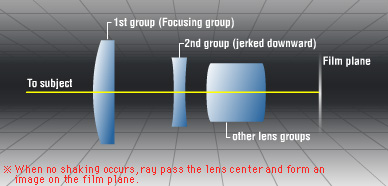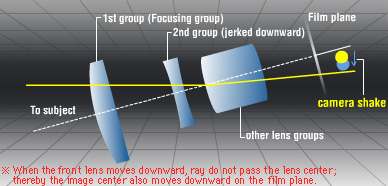1976-1986
Evolution into Fully Automatic Cameras with Electronic Controls
Canon AE-1, the world’s first camera with an embedded microcomputer, accelerated the incorporation of automatic and electronic technologies with the 35mm SLR camera. The flagship camera “F-1″ was reborn as the microcomputer-controlled “New F-1.” The Autoboy series, the world’s first lens-shutter 35mm autofocus (AF) cameras were also marketed, symbolizing the shift of lens-shutter camera into that with AF function. The sign of the new era in the camera world was visible already by the developmental activities in movie video cameras and still video (SV) cameras.
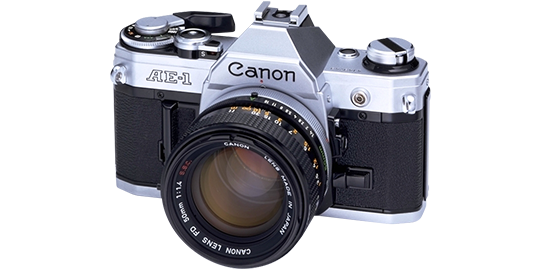
“AE-1,” the Pioneer of Automated and Computerized Camera, Leading to the “New F-1,” the Advanced Camera System
During the first Oil Shock in 1973, Japan suffered from hyper-inflation, and it was said that the salary of Canon’s employees rose over 35% for two consecutive years. In those days there were calls within the company for development of a fully automatic camera. In January 1974, some 100 engineers were mobilized to form a product development team under the “New Model X Development Plan.”
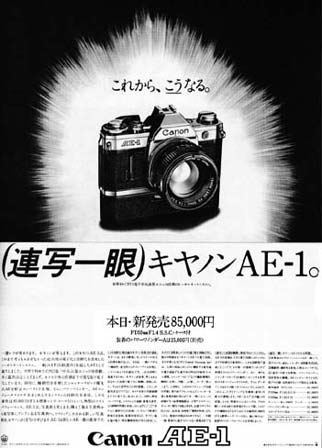
“AE-1″ newspaper ad
In April 1976, Canon unveiled the new model X, that is the “AE-1″ camera. The development concept of “AE-1″ was that anyone could take pictures with high cost-performance. Canon successfully combined the advanced design technologies for camera electronics, precision mechanics, optics and computer-aided designing, with manufacturing technologies for ultra-precision machining, automatic machining and automated assembly. The “AE-1″ was the world’s first 35mm AE SLR camera equipped with the shutter speed-priority TTL metering and a Central Processing Unit (CPU). The accessory “Power Winder A” allowed continuous shooting at two frames per second, and so its tagline was “Continuous Shooting SLR.” The “AE-1″ had epoch-making automated functions such as automatic flash exposure control using dedicated Speedlites for the camera.
Although Canon had already introduced the “EF,” 35mm AE SLR camera for mass-market, the “FTb” camera with TTL manual metering was still a major leading force in mass-production models. Canon recognized the need to develop a new model to become the top 35mm SLR camera manufacturer. The “AE-1″ gave the impetus to change the direction of the development of 35mm SLR cameras throughout the industry.
While “AE” stood for “Automatic Exposure Control,” the name of “AE-1″ implied the company’s objective to provide a camera representing the top of the line of “Totally Automatic Systems by Electronic SLR Cameras.” The catch phrase, “Continuous Shooting SLR” took the world by storm and permeated to general public. Canon initiated a TV commercial campaign on national networks, featuring world-renowned tennis and golf players. This was a first for a Japanese camera manufacturer. On release of the camera in United States, the campaign strategy proved to be a great success with record sales.
“A-1,” Fully Automated and Computerized Camera with Multiple Functions
The “A-1″ camera with five AE modes was launched in April 1978, while the “AE-1″ continued to be a runaway hit. The “A-1″ equipped with a full-fledged digitally controlled micro-computer, attracted attention from inside and outside of the camera industry for its sophisticated electronic mechanism and multiple functions.
The five AE modes of “A-1″ were Shutter speed-priority AE, Aperture-priority AE, Program AE, Stopped-down AE, and Speedlite AE. The “A-1″ realized superb operability. For example, the shutter speed and the aperture could be easily set with the dials on the camera. The electronically controlled fully automatic system ensured high-precision control for the entire photographic process including metering, a significant increase in the volume of information displayed, and also low cost production thanks to integrating several parts into a single component.
With its multiple functions realized by full digital control, the “A-1″ became very popular not only with conventional camera fans, but also younger users such as junior and senior high school students who loved mechanics.
The automated and computerized technologies Canon nurtured with the “AE-1″ made further progress through the development of the “A-1.” Such advanced technologies evolved continuously and continued to the forthcoming “T” series and the current “EOS” series.
New FD Lens Aimed at Further Enhancement
As the automatic exposure control (AE) system of SLR camera advanced, the FD lens was also improved. The FD-series lens had enjoyed great support from users for employing such features as rear focusing and aspherical lens elements as well as realizing excellent image reproduction and superior color balance. There was still room for further improvement in the compactness and mounting system. Especially, the development of an easy and quick mounting system was the challenge for the New FD lens. In the previous series, the lens was tightened with an outer breach-lock ring, but an increasing number of professional and advanced-level amateur photographers who frequently used interchangeable lens cameras showed dissatisfaction with the mounting system and requested for a new one which provided a feel of complete lock. To meet the demand, Canon developed an instantaneous fit-and-lock mount system that retained interchangeability with earlier cameras and incorporated in the system into the New FD lens. The product markings were the same as those of FD lenses, but to differentiate them from the conventional FD lenses, “New” was added.
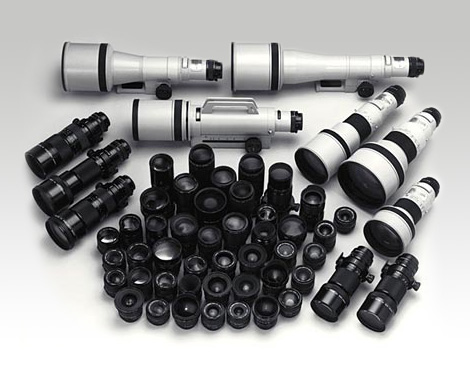
New FD-series lenses with improvements upon FD-series lenses
“New F-1,” the Refined Version of the Flagship 35mm SLR Camera “F-1″
Canon publicly announced its promise “not to change the basic specifications and functions of the F-1 for 10 years,” and the “F-1,” remained Canon’s flagship 35mm SLR camera throughout 1970s but by the end of the decade it was time for an update. With the trend to automated cameras with multiple functions based on the computer technology, it was good time for Canon to set to remodeling. During the decade after the introduction of the “F-1,” Canon gathered feedback from professional photographers and other “F-1″ users. There were a tremendous variety of comments, wishes, and applications that the designers could have never imagined. In order to produce a new model representative of the next-generation cameras, this valuable input was given due consideration and combined with the advanced technologies in various fields such as precision optics, precision mechanics, electrical and, electronic engineering and physical optics. The “New F-1,” next-generation high-quality flagship 35mm SLR camera was unveiled in September 1981.
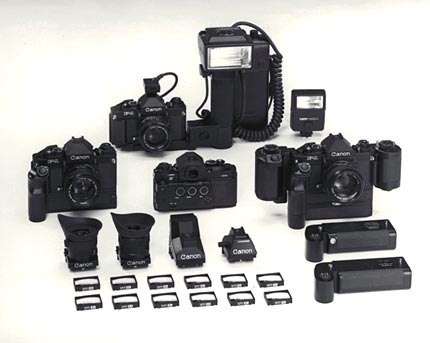
“New F-1″ with electronic technology and its components consisting the “F-1″ system
The basic philosophy or concept behind the development of the “New F-1″ was, as in the case of the “F-1,” putting an utmost emphasis on safety and reliability accented by high quality and precision. Following the “F-1″ system, “New F-1″ had even more advanced functions: Selectable AE modes from shutter speed-priority and aperture-priority, depending on the requirements and a hybrid shutter combining both electronic and mechanical mechanism to enable camera operation even without battery power. The external design was also based on the “F-1″ and kept the dignity as a top-of-the-line camera with state-of-the-art features. It had a palm grip for right-hand holding comfort, which was highly touted on the “A” series cameras. Thus several refinements were introduced in the “New F-1″ to improve the portability and shooting speed. Due consideration was given to the shapes and locations of operational parts such as the shutter dial, shutter button and film advance lever. These remained similar to those of “F-1″ so that the “F-1″ user could operate the “New F-1″ with a sense of familiarity. Although compatibility with accessories for the “F-1″ was sacrificed due to the necessity to incorporate the latest functions, significant upgrades were made such as five interchangeable viewfinders, 32 focusing screens, a five-frames–per-second motor drive, and a film chamber enabling continuous shooting of 100 frames.
The “New F-1,” designed exclusively for professional use, achieved the development goal to ensure reliability even under the harsh conditions and was designated as the official 35mm camera for 1984 Summer Olympic Games in Los Angeles, U.S.A. The “New F-1″ helped professional photographers in capturing a lot of valuable moments at big events around the world.
In 1984, Canon completed a “New F-1″ based model featuring a high-speed motor drive with the world’s fastest continuous shooting speed of 14 frames per second. The “New F-1 High Speed Motor Drive Camera” was released as a limited edition for professional photographers in sports and other specialized fields.
T-Series Camera Created by Groping for Clues
During the second Oil Shock period, the demand for cameras declined, and an increasing number of consumers preferred low-priced lens-shutter cameras to the SLR. To cope with such unfavorable circumstances, Canon decided to develop the T-Series SLR cameras to replace the A-Series, based on a new concept of AE cameras to meet the diversifying lifestyles and tastes of consumers.
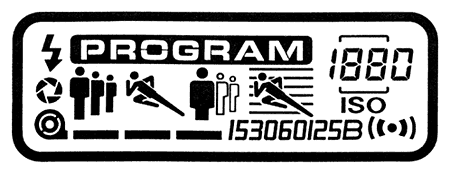
Pictograph of the “T80″ that simplified shooting process
Canon successively launched the T-Series cameras including “T50″ in March 1983, “T70″ in April 1984, and “T80″ in April 1985. The “T80″ employed pictographs for easy picture-taking by any user. The T-Series cameras incorporated thoroughly automated mechanisms for easy and simple shooting. In February 1986, Canon marketed the “T90″ targeting at advanced amateur and professional photographers. But, those days the automated and computerized cameras were experiencing hardship finding the most appropriate functions. What type of cameras would users want? In response to the changing environment, the T-Series cameras were born.
Birth of Autofocus Compact Camera, “AF35M”
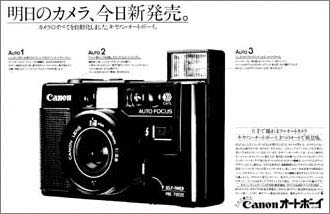
Ad for “AF35M (Autoboy)” that employed the active AF system
Spurred by the severe competition in the autofocus (AF) market, Canon developed its first AF lens-shutter camera, “AF35M (Autoboy).” Konishiroku Kogyo (currently Konica) succeeded in commercializing the world’s first AF camera named “Konica C35AF” in 1977. Thereafter, all the major manufactures followed suit. The AF mechanism of these cameras employed an autofocusing element called Visitronic, which was developed by Honeywell of the United States. It was a passive AF system that electronically detects two patterns (images) of a subject and calculated the distance by triangulation. Canon decided not to use this AF module because it was inadequate for low-light or low-contrast subjects, and started research on its original AF system. The company completed an infrared active AF system, enabling focusing in the dark. Two years after the release of “C35AF,” in November 1979, Canon launched the “AF35M,” lens-shutter camera with the infrared active AF system.
The active AF system incorporated in the “AF35M (Autoboy)” was based on the triangulation using a near infrared diode. Instead of having a moving rangefinder mirror as employed by passive AF system, a light-emitting diode was swung through an arc. The active AF system could achieve focus in the dark and work regardless of subject brightness and contrast. And since it did not require two optical images to focus, focusing was possible at close distances. These unique features and other convenient functions such as automatic film winding and rewinding, program AE, and autoflash AE, the “Autoboy ” soon became the generic name for fully-automatic AF compact cameras.
End of the 8mm Film Cinecamera and Advent of the Video Camcorder
Electronic imaging, or the video camcorder business, was outlined as a future project. Although tough competition was expected as many electric appliance manufacturers had entered into this business, there was a consensus in the company that Canon, a camera expert in high-quality images, should never lag behind in any new business for imaging technology, and thus was involved in development projects based on optical technology.
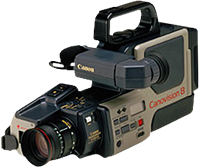
“Canovision 8VM-E1″ received the Good Design Award
As manufacturers in the world started to standardize on the 8mm video format in 1981, Canon made an entry into the video camcorder business at full scale, a result of focusing on the 8mm video standards from the outset. In 1983, through the company’s reformation, the Electronic Imaging division became independent of the Camera division. Then it entered the video camcorder market, competing with the household electric appliance manufacturers, who already boasted an ample track record. In 1985, Canon released the “Canovision 8VM-E1,” the first integrated 8mm video camcorder in the world. The camcorder was equipped with a compact high-performance 6X power zoom lens with large f/1.2 aperture. With its lightweight compact body and various advanced functions such as still image playback and recording /playback, it was nominated for Good Design Award of the year.
Along with the advances of the sound mechanism for the 8mm film cinecamera, Canon introduced its first sound 8mm film cinecamera “514XL-S” in September 1976, followed by a cine projector with sound function,”PS-1000″ In March 1977. But, the major trend was shifting from the 8mm film cinecamera to the video camcorder. In September 1982, Canon released the “AF310XL,” and its alternate version with sound function, “AF310XL-S.” Production of both models was halted in1985, and the 30-year history of 8mm film cinecameras that started with the “Canon Cine 8T,” came to a end.
Development of Still Video (SV) Camera
Although the silver-halide based camera with nearly 160 years of history had been dominant through that time, the development of an electronic technology based magnetic recording still camera had been quietly under way for quite some time. A magnetic recording still camera would not require the film developing process, because it would not use conventional film. In addition to the easy image processing, it would also have the merit of easy transmission of images. Although Canon was involved in the development of the magnetic recording technology, the possibility of its commercialization was considered low as the stringent standards of image quality that a camera manufacturer needed to follow was not satisfactory yet.
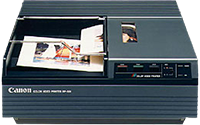
Color Video Printer “RP-601″
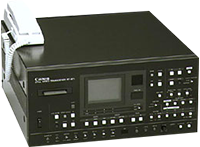
Still Video Transceiver “RT-971″
Sony launched the “Mavica” still camera with magnetic recording system in 1981. In anticipation of the arrival of the magnetic recording still camera era, Canon formed a task force to develop a magnetic recording color still camera in October 1981.
In the course of developing the magnetic recording still camera, the 1984 Los Angeles Olympic Games provided an excellent opportunity for experimental use of image transmission. At the request of the Japanese newspaper, Yomiuri Shimbun, Canon was involved in the image transmission experiments. The time given for the entire process was only 10 months. After conducting field test, training for photographers, preparation of export documents, and taking other necessary procedures in Japan, only 5 months were left to develop and design the electronic transceiver and the playback machine, and complete the prototypes. Without question, the schedule was very tight. During the broadcasting of the men’s marathon, the automobile telephone attached to the electronic transmitter failed to work, and the information had to be transmitted over a public telephone. Anyway, the experiment proved successful, giving invaluable know-how in the development of magnetic recording still cameras.

Still video (SV) camera system

“RC-701,” the world’s first commercial magnetic recording still camera
Based on data and experience from the tests at the Los Angeles Olympic Games, Canon started to produce a magnetic recording still camera. The still video (SV) camera “RC-701″ and a group of system components were introduced in 1986. Since the release of the “Mavica” by Sony, several electronics appliance manufacturers and camera manufacturers had developed prototypes, but Canon’s “RC-701″ was the world’s first commercialized product.
The magnetic recording still camera used the analog recording system, but the know-how and technology gained through the research and development of the SV camera laid the groundwork for today’s digital cameras.

